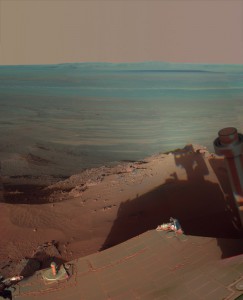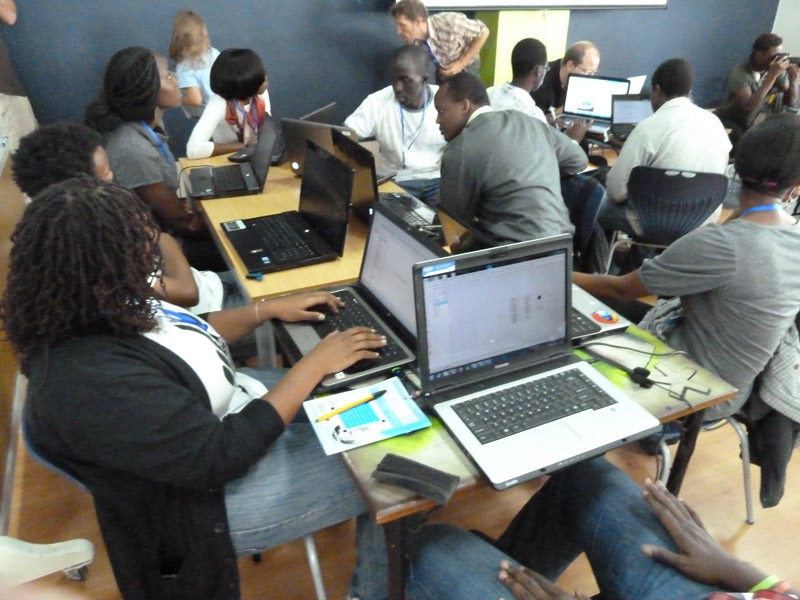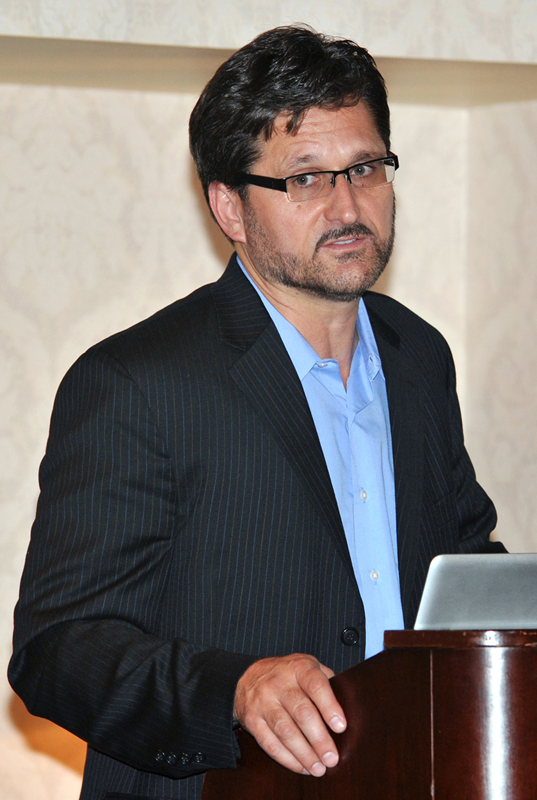
NASA's Mars Rover Opportunity catches its own late-afternoon shadow in this dramatically lit view eastward across Endeavour Crater on Mars. Photo Credit: NASA/JPL-Caltech/Cornell/Arizona State University
May 30, 2012 — Vol. 5, Issue 5
It takes more than a little hand sanitizer to protect the worlds we explore.

NASA’s Mars Rover Opportunity catches its own late-afternoon shadow in this dramatically lit view eastward across Endeavour Crater on Mars.
Photo Credit: NASA/JPL-Caltech/Cornell/Arizona State University
Within the last twelve years, the National Research Council (NRC) has released two reports on the topic of protecting icy bodies such as Europa from contamination by Earth life. The most recent report, Assessment of Planetary Protection Requirements for Spacecraft Missions to Icy Solar System Bodies, released in May 2012, reexamines the measures taken to preserve them. ASK the Academy sat down with Cassie Conley, NASA’s Planetary Protection Officer, to gain insights about the development and evolution of planetary protection policy.
ASK the Academy (ATA): In general, how does planetary protection fit into NASA’s mission? Why do it?
Cassie Conley: The safest thing to do in terms of planetary protection is not to explore other worlds, but we’re not going to do that. Instead, we have to figure out how to do it in a way that minimizes the risk to the planet or body, but also maximizes the degree to which the mission accomplishes its scientific goals. So there’s this tradeoff. For any particular mission that has planetary protection obligations, that mission will need to identify a planetary protection lead, and that person then works with people in my office to make sure that everything is in compliance.
If there are humans still around in 10,000 or 100,000 years, scientists are still going to have the same interest in understanding life at Europa as we do now. Planetary protection is trying to prevent actions today that might contaminate Europa and interfere with that future science. We are protecting the future of science.
ATA: When was policy for planetary protection first introduced?
Conley: Planetary protection is done in compliance with Article IX of the Outer Space Treaty from 1967, but goes back much longer than that. It has clauses that specify that you don’t contaminate other places with Earth life, and you don’t contaminate the earth with alien life. While that is the policy, there aren’t any instructions on how to implement it. NASA, being one of the first organizations to send spacecraft into space, developed a series of procedures and activities and guidelines that it followed. As more organizations began to explore space, it became clear that if they didn’t take similar precautions, then NASA could take all of the precautions in the world and it still wouldn’t be able to investigate any life except Earth life because it will be there before we have a chance to actually look for something new.
ATA: How was planetary policy introduced at the international level? How is it maintained?
Conley: There’s an international body called the International Council for Science (formerly the International Council of Scientific Unions), which is made up of the national academies of many nations: the National Research Council in the U.S., the Russian academy, the European Science Foundation, etc. This is the international body where scientific policy is developed on an international level. The International Council on Science has a committee on space research called the Committee on Space Research (COSPAR), which is where space science policy is developed.
COSPAR has a funded panel on planetary protection, which is where international planetary protection policy is made. COSPAR advises the U.N. Committee on the Peaceful Uses of Outer Space (COPUOS), the U.N. organization that enforces the Outer Space Treaty. The standing panel on planetary protection provides the international guidelines that tell organizations how to comply with the Outer Space Treaty. So there’s a very close connection between COSPAR policy and compliance with the Outer Space Treaty on an international level. It’s not actually law, but it’s 50 years of precedent. It’s been going on for a long time.
NASA policy specifies that it will only participate in missions that follow COSPAR policy. Everybody follows the international guidelines. It’s a useful tool for international relations, collaboration, and space exploration. Of course, much of the advice that has been adopted by COSPAR was provided by the National Research Council Space Studies Board because NASA had a very big program in space exploration early on. Over time, we have all come to agreement with the policies in place.
ATA: There are measures in place to help determine the level of confidence that a given mission will not contaminate another body. Can you talk us about these and how they ease our concern about contaminating a place like Europa?
Conley: For Europa, contamination is a difficult problem. In order for Earth life to grow on outer planets, it has to get into a habitable environment, survive, and proliferate. That is something that would potentially happen on a very long time scale. Because there are so many different organisms that we know so little about, there’s a lot of fuzz about whether or not we’ll contaminate.
There is a lot of stuff we don’t know about Earth organisms. They can do a lot of things we still wouldn’t have expected, and we’re discovering new clever things about them all the time. Starting out with an assumption that Earth life won’t be able to grow somewhere else is not something we’re going to do. We recognize this on multiple levels.
The requirement that we’re trying to meet is a 10-4 probability of contaminating. That means a one-in-ten thousand chance of contaminating, or a 99.99 percent chance of not contaminating. There’s a lot of confidence there. Because we know so little about these objects, it turns out that there’s not a single point at which you can say, “Yes, I have 99.99 percent confidence that I can deorbit the mission into Europa or Jupiter and not contaminate.”
Research that my program has been funding has published findings that suggest that the probability is a lot closer to 1 [meaning an event is more likely to happen] than we might have expected, but it took 10 years to figure that out. We found out that an organism that lives on cheese in your refrigerator will also survive under Mars ambient pressure, Mars atmosphere, Mars simulated soil, (at) zero degrees Celsius, as long as it’s sheltered from the ultraviolet light. So there is a lot of conservatism that we impose on planetary protection in order to compensate for this problem. The idea that we don’t have to worry about Earth life is a non-starter.
The way that we’ve handled this follows very closely with 50 years of planetary protection policy. We use a set of reduction factors. For your mission, before your spacecraft launches, you have a known number of organisms on your spacecraft. You can reduce that number of organisms by a series of factors, either because you killed them off before you launched, they died during flight, they died in the radiation environment at the target planet, they can’t get to the liquid water because they go splat on the surface, or they burn up because the spacecraft is going really fast. That’s all mission-dependent, and so there are a lot of different factors that you might include. In a general policy you have to say you might consider this one, you might consider that one, or a series of things over the timeline of the mission.
ATA: Can you give us an example of how those reduction factors might be used on a mission?
Conley: For the Juno mission, there were a couple of things going on. In the original Europa report, it was recommended (that) you have to worry about contamination of the ocean inside Europa forever. Of course, if the organisms are dead, they’re not going to grow, and so the timescale is not forever. While discussing how to implement planetary protection for Juno, we recognized that we only need to worry until all of the organisms on the spacecraft are dead. For Juno that turns out to be about 300 years.
There are also many ways to kill organisms. Before the Juno project realized 300 years was a good cutoff, they had modeled 1,000 years. The End-of-Mission plan is for Juno to dive into Jupiter at the end of the mission, but there’s a 5 percent chance that this will fail. So, 5 percent of the time the deorbit doesn’t happen, and as the orbit propagates, over 300 years there’s a chance that the spacecraft could hit Europa but in 90 percent of the impact cases its going to be going 22 kilometers per second, which is awfully fast.
At that point we realized, for the impact cases within 300 years before everything is dead, that impact lethality is a really good way to kill the rest. So we incorporated an additional reduction factor based on that observation about the specific Juno mission scenario, which then allowed them to meet their planetary protection requirements with an order of magnitude to spare. This demonstrates the usefulness of the reductions factor approach you can add additional mission-specific reduction factors that help the mission get to where they need to be.
ATA: You also use something called the Coleman-Sagan probabilistic formulation to determine the likelihood of contamination. Can you explain what that is?
Conley: It’s a version of a formula that was developed by Carl Sagan and Max Coleman in the 1960s. Its like the Drake equation for how many intelligent species there are. Basically, all of the reduction factors are so loosely defined that essentially you could come up with any number you want to if you pick the factors correctly. This is a known problem and is the reason we have careful review process that missions go through. We recognize at planetary protection level that you have to make sure that we are actually using independent reduction factors for all of the various considerations that you need to go into to use the equation the right way. Its easy to lie with statistics the challenge is making sure that missions do it correctly.
ATA: It’s been nearly twelve years since the NRC looked at the contamination of icy bodies like Europa. What prompted this second report?
Conley: The 2000 report was presented to COSPAR, which made some adaptions in the principles, and we made some changes to the actual implementation because of these problems that we recognize with the Coleman-Sagan formulation. As a result, a series of reduction factors were accepted at COSPAR level and into NASA policy.
In 2006-2007, NASA and ESA started discussing the possibility of doing joint missions to the Jupiter system. At COSPAR level, we recognized that there are still a lot of things we don’t understand, so we planned a workshop. It turned into two workshops looking at lots of different icy bodies in the outer solar system, trying to figure out how we prevent contamination of them and what things we really needed to worry about.
COSPAR set up this framework for icy bodies where you’ve got the ones that were sure about, the ones we know were not sure about, and the ones that we don’t worry about. For instance, we have pretty high confidence that for objects less than half the size of Pluto there is no liquid water. For places like Europa and Enceladus, we have quite high confidence that there’s some warm ice or liquid water there. Ganeymede, Triton, Titan were objects we recognized as probably having liquid water inside them, but its deep beneath the surface. There were two reports produced from those workshops in 2009 that were setting the framework, but we needed better resolution, we needed a better understanding of what factors should be considered and are there any that we haven’t thought of so far that other people who are clever might be able to think up in terms of a particular mission scenario? That is what prompted the latest NRC report.
ATA: What changes, if any, should NASA and international missions expect to see as the NRC input is taken into consideration?
Conley: The policy that we have now is still going to be the framework. NASA follows COSPAR, so we will still be using a reductions factor approach. We hope have better refinement on some of the parameters that need to go into that reductions factor approach. That’s the level at which it will be affecting missions. Were already conservative with our 10-4 confidence level. Were not going to make it harder on missions. We will pull out useful information and points raised in the report.
Keep in mind (that) given the number of agencies that are now participating in space exploration, NASA isn’t quite as big of a gorilla as it used to be in terms of international policy. Everyone has the same objective: were trying to understand the origin and evolution of life in the universe.









